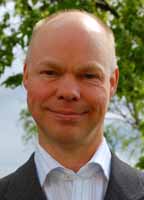Disaster warner and revolution catalyst in one
Researchers at KTH have now developed a system for wireless sharing and communication which they call Podnet. The aim has been to investigate and facilitate sporadic communication between different devices, such as mobile phones, mp3 players and tablet computers. According to Gunnar Karlsson, Professor of Communication Networks and head of Podnet, there are many areas of application for the system.

Three of them could be to support the search for people in natural disasters, as part of an alarm system for natural disasters such as tsunami warners or for example as a channel for the opposition in Libya to communicate.
“Podnet could also be used for the democratic management of infrastructure. Imagine that you are sitting in a lecture. Suddenly, you receive a question via your mobile phone regarding whether the sound is high enough or if the heat in the room is ok. You can then answer the question, and if enough people in the audience feel the same as you, the temperature, the sound, the stage lighting or whatever it may be, will be corrected,” says Gunnar Karlsson.
Podnet makes it possible for mobile phones, mp3 players, tablet computers or digital cameras to talk to each other over Wi-Fi. It is about connecting technical communication devices which consist of random contacts with units which happen to be close to each other.
”It is the actual information that is most important, not specific individuals, computers or IP addresses. We are turning the given concept and the legacy which the world of telephony has given us upside down. That is, communication between two specific people or computers with designated numbers or addresses,” says Gunnar Karlsson.
He gives YouTube and an overloaded 3G network as examples. Why should a popular movie clip be downloaded to each of a variety of users when the users among themselves can share the files they have saved on their mobile phones or tablet computers?
When asked what happens when only half a file or half of a message is transferred during a brief connection, Gunnar Karlsson explains that he and the other researchers are trying to maximize the transfer of information in as short a time period as possible.
“We are looking at the construction of a popularity list, where mobile phones or other devices can build up the type of files that are most in demand. It’s about thinking collectively. A fair share of the population are probably searching for the same files. What is demanded, is also distributed, the system adapts to what is most desired,” says Gunnar Karlsson.
He adds that certain points in Podnet can be connected to the Internet.
“Our system would be able to take advantage of such an access point. In that way you can get information from the Internet to Podnet. The opposite is also true, to send information or data onto the Internet from Podnet,” says Gunnar Karlsson.
There were reasons why Wi-Fi and not Bluetooth became the primary technology behind Podnet.
“Bluetooth takes quite a long time to connect and establish a communication channel, Wi-Fi only takes a few seconds,” says Gunnar Karlsson.
Podnet has left the drawing board and is being used in actual service at Gunnar Karlsson’s department for those who want to test it.
For more information, contact Gunnar Karlsson at 08-790 42 57 or gk@ee.kth.se.
Peter Larsson

